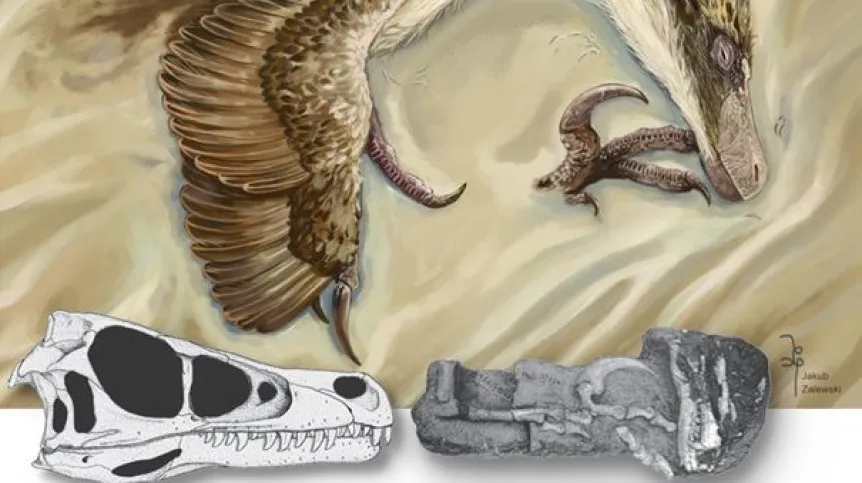
Computed tomography allowed has allowed scientists to examine the predatory dinosaur skull found 50 years ago by a Polish-Mongolian expedition in the Gobi Desert. The research results have been published in the latest issue of Acta Palaeontologica Polonica.
The research was conducted by Dr. Łukasz Czepiński from the Institute of Paleobiology of the Polish Academy of Sciences.
'Although these bones were discovered in the Gobi Desert during the Polish-Mongolian Palaeontological Expeditions over fifty years ago, they have never been described in detail. I studied them as part of my doctoral dissertation on Cretaceous vertebrates from Mongolia,’ says Czepiński.
According to the researcher, in the 1990s the specimen was cleared of sandstone sediment from the palate side, 'however, it was impossible to extract it completely from the rock - it would have damaged the delicate bones of the skull. Fortunately, we now have non-invasive techniques, such as computed tomography. Thanks to this, I was able to extract the remains from the rock virtually, without the risk of damaging the priceless fossil,’ says Dr. Czepiński.
Initially, the specimen was misidentified as the famous velociraptor. These dinosaurs were dromaeosaurs - two-legged predators inhabiting the territory of today's Mongolia at the end of the Cretaceous - about 70 million years ago (they were made famous by Michael Crichton's book Jurassic Park and Steven Spielberg's film of the same title; in fact, they were half the size of the dinosaurs from the book and movie). Anatomically, they resembled today's birds more than reptiles; they were also covered with feathers. Velociraptors were very fast and quite agile.
Closer examination of the skull from the Gobi Desert, however, contradicted its identification as a velociraptor. 'My research, based on computed tomography data, shows that it differs significantly in the proportions of the skull - it is shorter and deeper than that of a velociraptor. It inhabited a less desert environment, and it is possible that it was of a slightly different geological age,’ Czepiński says.
He adds that the specimen was preserved in a rather interesting way, with the skull pressed against the left leg, which makes the animal look as if it was scratching its chin with its foot. 'This makes it quite similar to a once popular internet meme ('Philosoraptor'). At the same time, I was able to compare this specimen with another skeleton found in the same place by American scientists, one that was almost complete - only the head was missing. Comparison of the anatomy of the foot bones preserved in both specimens, showed that they belonged to the same species, distinct from the velociraptor, named Shri devi by American researchers. Now this headless dinosaur has a skull,’ says Dr. Czepiński.
Unlike other dromaeosaurs from Mongolia, Shri devi had a relatively short snout, reminiscent of North American species proportions. It is possible that the similar skull anatomy of these animals may result from adaptation to less arid environmental conditions.
Dromaeosaurs, including Shri devi, ate small vertebrates (mammals and lizards) inhabiting the desert regions of the Gobi about 70 million years ago. 'It is possible that they also hunted slightly larger herbivorous dinosaurs, such as protoceratops,’ says Czepiński.
The Gobi Desert continues to attract researchers from all over the world who conduct intensive excavations together with Mongolian palaeontologists. 'Polish researchers have not carried out major expeditions in that region since the 1970s, but the topic of collaboration between Polish and Mongolian palaeontologists is still alive,’ Dr. Czepiński says. (PAP)
PAP - Science in Poland, Magdalena Barcz
bar/ zan/ kap/
tr. RL













